|
Author
|
Topic: Apollo boilerplate capsules: missing histories
|
moorouge
Member Posts: 2486
From: U.K.
Registered: Jul 2009
|
 posted 11-08-2010 04:35 AM
posted 11-08-2010 04:35 AM
   
It is becoming clear that the history of the Apollo boilerplate capsules is sketchy at best.A Field Guide to Apollo Spacecraft gives a list. However, there are some anomalies. For example, BP-1215 is not listed but was, it is claimed, based at Yokosuka in Japan. Was there such a capsule? Two other boilerplates mentioned in the Field Guide are BP-1204 listed as being at the Garber Facility, Suitland, MD, the National Air and Space Museum's storage facility. This capsule was apparently based in Rota, Spain. The other, BP-1223 is listed as being 'Salvaged'(?), but was, again apparently, based in the Azores. |
PeterO
Member Posts: 444
From: North Carolina
Registered: Mar 2002
|
 posted 11-10-2010 04:59 AM
posted 11-10-2010 04:59 AM
   
My high school displayed an Apollo boilerplate in the early 1970s. I graduated in 1972, and the boilerplate remained there for several years afterward. It sat outside next to the faculty parking lot. The school was Oyster River High School, in Durham, New Hampshire.In the 1980s I attempted to find out what had happened to the boilerplate, but nobody in the school administration had any information about it, and indeed, nobody remembered it being there. |
moorouge
Member Posts: 2486
From: U.K.
Registered: Jul 2009
|
 posted 12-20-2010 04:05 AM
posted 12-20-2010 04:05 AM
   
The curious case of another mishap with an Apollo boilerplate capsule is reported today.In 1980, there was a UFO sighting in Suffolk which is widely claimed to be Britain's most famous. Now, it turns out that this may have been BP-1206 which was dropped by a helicopter from the 67th ARRS operating out of RAF Woodbridge. The capsule was dropped in a wood near the airbase as it was being returned from an exercise. It is said that the UFO story was encouraged by the American airmen to cover up the fact that there had been an incident. The capsule was recovered the next day. What is curious about this is the date; 1980 is well after the ending of the Apollo flights. Do we have another mystery? |
butch wilks
Member Posts: 336
From: Lowestoft, Suffolk, UK
Registered: Mar 2007
|
 posted 12-20-2010 01:34 PM
posted 12-20-2010 01:34 PM
   
Sorry, not possible. Some background: I visited and worked on the bases for a number of years from 1970 to now and back in late 1977 BP-1206 was sent back to NASA on a C-141. I was on the base at the time and it had a big sendoff.As a side note, the 67th ARRS got in the first of the shuttle mockups in the first two months of 1978. Moving on to the 1980's sighting: one more time, I was on the base at the time and it is not possible that a helicopter from the 67th ARRS was flying that night, as we had a bad ground fog for the days of the sighting and ALL flights were grounded at the time. Plus the A-10 aircraft base at RAF Woodbridge and Bentwaters at the time did not have night vision aids as they do now, so they did not fly at night. |
moorouge
Member Posts: 2486
From: U.K.
Registered: Jul 2009
|
 posted 12-23-2010 07:27 AM
posted 12-23-2010 07:27 AM
   
Another curious thing to come out of delving into boilerplate histories.It would seem that recovery crews practiced with wooden mock-ups of the capsule. This was typically a three quarter capsule built round the hatch area. Inside would be chairs on which dummies were placed so that recovery personnel could perfect procedures for extracting the crew. Most were broken up or burnt after the Apollo flights finished. However, it would be interesting to see if anyone out there has a photo of one of these wooden wonders. |
Captain Apollo
Member Posts: 330
From: UK
Registered: Jun 2004
|
 posted 12-30-2010 08:49 PM
posted 12-30-2010 08:49 PM
   
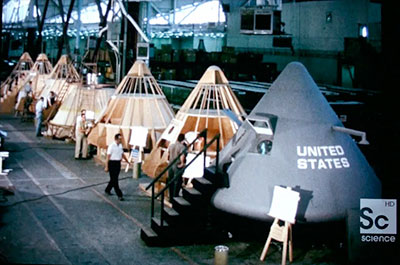 |
moorouge
Member Posts: 2486
From: U.K.
Registered: Jul 2009
|
 posted 01-26-2011 04:35 PM
posted 01-26-2011 04:35 PM
   
I can add an update to the Field Guide to American Spacecraft:Apollo boilerplate BP-1206, then in the possession of the 67th ARRS located at the Woodbridge RAF, was transferred to the Smithsonian in title only on 29 April 1976. Eventually, in July 1977 a loan agreement was executed between the Smithsonian and the 67th ARRS. Through the 1980s that loan was periodically renewed through various offices of the 67th ARRS. Throughout this period the capsule continued to be used as a training vehicle. However, following the Rendelsham UFO incident it was moved away from its site in front of the 67th hangar to a secluded spot out of the view of the public. In June of 1991, at the discretion of the U.S. Air Force, and as subsequently reported to the Smithsonian, the boilerplate spacecraft was shipped to the 71st ARS at Patrick Air Force Base in Florida. Eventually new loan arrangements were executed between the Smithsonian and the Rescue Squadron at Patrick Air Force Base. |
moorouge
Member Posts: 2486
From: U.K.
Registered: Jul 2009
|
 posted 02-06-2011 01:57 PM
posted 02-06-2011 01:57 PM
   
Another piece in the history of the Apollo boilerplates gleaned from the Apollo chronology - February 5A Senior Flammability Review Board meeting at MSC reached a number of decisions on the CSM. Attending were Robert R. Gilruth, chairman; George M. Low, Kenneth S. Kleinknecht, Aleck C. Bond, Maxime A. Faget, Donald K. Slayton, Charles A. Berry, and Rodney G. Rose, all of MSC; Samuel C. Phillips, NASA Hq.; William B. Bergen and Dale D. Myers, North American Rockwell; and George Stoner, Boeing (nonvoting observer). Several previous action assignments were reviewed: - Component level Flammability Test Program - North American reviewed the results of its material identification and test program, the component test program, and the boilerplate 1,250 tests. These tests had provided the basis for design decisions on selection and application of CM nonmetallic materials.
- Boilerplate 1224 configuration comparison to CSMs 2TV-1 and 101 - North American presented the comparison and the Board decided that the boilerplate configuration was representative of the "worst case" configuration, considering both 2TV-l and 101.
- Internal ignition rationale - ignition rationale for the boilerplate 1224 tests was presented to the Board. Nichrome wire ignitors were used with the ignitor wire embedded in potting. In some locations a Ladicote cover was applied over the potting and ignitor. The Board pointed out that the ignition techniques were not really representative of actual operating conditions and were indeed overly severe.
- Crew communications umbilical - North American was evaluating a fluorel crew communications umbilical as well as fluorel oxygen umbilicals. A Beta sleeve over the oxygen and crew communications umbilicals would also be evaluated for its operational acceptability by the Crew.
The Board presented a review of test results. In the tests at pressure of 4.3 newtons per square centimeter (6.2 pounds per square inch) in a 95-percent oxygen atmosphere, there were 38 ignitions in boilerplate 1224. Of these, 5 produced fires large enough to require further consideration. In tests at 11.2 newtons per sq cm (16.2 psia) in a 60-percent-oxygen and 40-percent nitrogen atmosphere, there were 31 ignitions. Of these, 4 produced fires large enough to require further consideration.The Board concluded that the material changes made in the CM had resulted in a safe configuration in both the tested atmospheres. The Board agreed "that there will always be a degree of risk associated with manned space flight," but the risk of fire "was now substantially less than the basic risks inherent in manned space flight." These tests were a direct result of the Apollo 1 fire. |
moorouge
Member Posts: 2486
From: U.K.
Registered: Jul 2009
|
 posted 02-11-2011 10:51 AM
posted 02-11-2011 10:51 AM
   
I have found a boilerplate Apollo capsule that was sunk. This capsule was reported as sunk by naval gunfire after it broke from a ship's towline by The New York Times on 27th May 1967.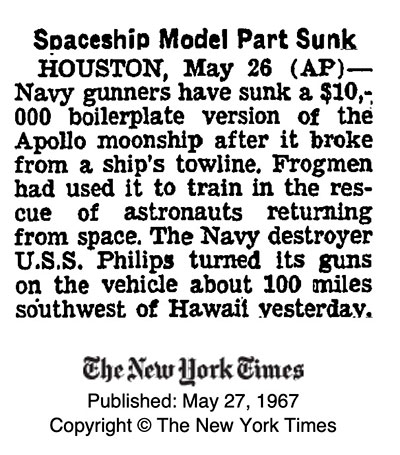 |
history in miniature
Member Posts: 618
From: Slatington, PA
Registered: Mar 2009
|
 posted 02-11-2011 12:15 PM
posted 02-11-2011 12:15 PM
   
How did a mock-up make it to a Dairy Queen's front yard here in Pennsylvania? |
Robert Pearlman
Editor Posts: 49316
From: Houston, TX
Registered: Nov 1999
|
 posted 02-11-2011 12:16 PM
posted 02-11-2011 12:16 PM
   
See: Apollo boilerplate at Pennsylvania Dairy Queen |
dabolton
Member Posts: 419
From: Seneca, IL, US
Registered: Jan 2009
|
 posted 04-22-2011 10:12 AM
posted 04-22-2011 10:12 AM
  
There is an Apollo capsule sitting at the Harris County Youth Facility near Johnson Space Center. I always remember seeing that as kid in the neighborhood but never knew its story; whether it was real or fake. |
jklier
Member Posts: 90
From: Austin, Texas
Registered: Aug 2007
|
 posted 04-29-2011 08:20 AM
posted 04-29-2011 08:20 AM
   
quote:
Originally posted by moorouge:
I have found a boilerplate Apollo capsule that was sunk.
From Armand Hoffstetter who was aboard the USS Philips: I do remember our failure to retrieve the dummy re-entry pod. There was a considerable rolling swells causing a lot of movement of the aft deck. Some part broke and we were not going to be able to tow the dummy; too much drag for any attachment point nor could it be left in the sea lanes. The decision was to sink it. A couple of 5" holes and it sank. |
moorouge
Member Posts: 2486
From: U.K.
Registered: Jul 2009
|
 posted 04-29-2011 11:02 AM
posted 04-29-2011 11:02 AM
   
The capsule number would be helpful, if he knows. It was certainly a 1200 series, but which one? |
moorouge
Member Posts: 2486
From: U.K.
Registered: Jul 2009
|
 posted 11-08-2011 03:32 AM
posted 11-08-2011 03:32 AM
   
quote:
Originally posted by dabolton:
Apollo capsule sitting at the Harris County Youth Facility
It was a BP used at the Manned Spacecraft Center (now Johnson Space Center) for the flammability testing, BP-1224. Another capsule used was BP-K, a converted BP-1200, and now in Talon Park at Space Center Houston. |
moorouge
Member Posts: 2486
From: U.K.
Registered: Jul 2009
|
 posted 11-10-2011 01:46 AM
posted 11-10-2011 01:46 AM
   
To fill in something of the early days of the Apollo boilerplates.The first command module boilerplate to be completed was BP-25 on 7th August 1962. Following testing in the waters off Los Angeles, it was delivered to NASA in mid-August. It was followed a month later, in mid-September 1962, by BP-1 and BP-3. (It's worth noting that in this same month NASA deleted five Apollo mock-ups and three boilerplates from a contract because of budget constraints.) The first "flying" test of a boilerplate was by BP-3 on 3rd May 1963 when, following a drop from a C-133, it made a successful test of the Apollo ELS (Earth Landing System). On the 6th September 1963, this boilerplate became the first to be destroyed when the parachutes failed while testing the configuration for the "on pad abort test" to be performed by BP-6. |
moorouge
Member Posts: 2486
From: U.K.
Registered: Jul 2009
|
 posted 11-18-2011 04:41 PM
posted 11-18-2011 04:41 PM
   
If you reference A Field Guide to American Spacecraft you'll notice that BP-14 is listed as "unknown." This can now be filled in. According to a NASA reference document, a letter (JF4-50799) dated 26 March 1971 directed Rockwell to dispose of the capsule through "regular property disposal procedures." It was offered to the Smithsonian but was declined. Following this, the 1978 NASA document says that BP-14 was sold to Kolar Inc. at Tucson, Arizona. Whether the boilerplate remains in Tuscon or whether it was subsequently scrapped is unknown. |
moorouge
Member Posts: 2486
From: U.K.
Registered: Jul 2009
|
 posted 05-10-2012 04:41 PM
posted 05-10-2012 04:41 PM
   
This is for those interested in the technical side of things and provides an insight into the testing of the Apollo spacecraft using the boilerplate capsules. It goes someway into filling in the history of these test vehicles. Unfortunately, from my perspective, it only deals with the testing and not the recovery aspects of the Apollo programme.One interesting fact concerns BP-18. In A Field Guide to American Spacecraft, this is listed as "unused." However, one of the following documents suggests that it was being prepared for a qualification test of the C-1 launch vehicle and to demonstrate the separation of the spacecraft from the launch vehicle following the S-IV burn out. This document is marked with an asterisk (*). Another capsule listed in the Field Guide as unused is BP-30 (aka BP-18). However, as is recorded below, there were plans to use it. The boilerplate capsules are listed in order with the really interesting documents in bold type. All the boilerplate configurations - SID 62-1408-2-VOL-2 *; SID 62-1434 - BP-1: Land and water impact test - SID 62-205; SID 63-143-4-R-1-REV
- BP-2: Land impact test - SID 62-206
- BP-3: Parachute drop test - SID 62-207; SID 63-143-2-R-1-REV
- BP-4: Water impact test - SID 62-208
- BP-5: Earth recovery - SID 62-209
- BP-6: Support manual - SM2A-07-BP6; SID 63-143-6
- BP-6A: Parachute drop test - SID 63-143-16
- BP-7: Water impact test - SID 62-211
- BP-9: Dynamics and ground test - SID 62-213
- BP-10: Water egress test - SID 62-214
- BP-11: CM recovery equipment test - SID 62-215
- BP-12: End item specification - SID 63-423
- BP-13: Support manual - SM2A-07-BP13; SID 63-620; SID 62-217 (SA-5 specification)
- BP-14: Number 1 specification (house spacecraft) SID 62-218
- BP-15: Chronology SA-7/A-102 - SP-207; Support Manual - SM2A-07-BP15; SID 62-219; Post flight - NAS 1.15.X-53171
- BP-16: End specification - SID 62-220; SID 63-691
- BP-19: Parachute drop test - SID 63-143-3; SID 63-143-3REV
- BP-22: High altitude abort test - SID 63-143-14; SID 65-793
- BP-23A: Working paper for PA-2 - 1158 & 1158A; Flight test report - SID 63-1416-8
- BP-26: End specification - SID 63-695
- BP-28: Weight/Balance report - SID 63-143-19
- BP-30: Preliminary weight/balance report - SID 65-793; Performance/design requirements - SID 64-1083 (to provide capabilities for unmanned LEM [sic] misson
In addition to these are Boilerplate Stack reports: - BP-12: SID 63-143-9W
- BP-15: SID 63-143-10
- BP-23: SID 63-143-12W
- BP-27: SID 63-143-13
|
dtemple
Member Posts: 755
From: Longview, Texas, USA
Registered: Apr 2000
|
 posted 05-10-2012 09:41 PM
posted 05-10-2012 09:41 PM
   
quote:
Originally posted by moorouge:
Following this, the 1978 NASA document says that BP-14 was sold to Kolar Inc. at Tucson, Arizona.
Checking Google for this company revealed this court document. The excerpt below shows the company was involved in aircraft scrap and salvage so based on that fact BP-14 was probably reduced to scrap metal. Sol Kotz owned Kolar, Inc., an Arizona business engaged in aircraft scrap and salvage. In early 1976 Kotz made his first commodities investments... |
dtemple
Member Posts: 755
From: Longview, Texas, USA
Registered: Apr 2000
|
 posted 05-10-2012 09:46 PM
posted 05-10-2012 09:46 PM
   
BP-30: Preliminary weight/balance report - SID 65-793; Performance/design requirements I read that BP-30 was to be used if another unmanned Saturn V test was needed after Apollo 6. The Apollo stack on the Saturn V at KSC I believe would have been payload for the flight had it been flown. As I recall the service module is SM-015. |
Obviousman
Member Posts: 438
From: NSW, Australia
Registered: May 2005
|
 posted 05-26-2012 06:57 AM
posted 05-26-2012 06:57 AM
   
I'm also trying to see if I can find out what happened to some "missing" Block I CMs: Anyone have any leads on these CMs? |
dtemple
Member Posts: 755
From: Longview, Texas, USA
Registered: Apr 2000
|
 posted 05-26-2012 11:35 AM
posted 05-26-2012 11:35 AM
   
As I recall, spacecraft 001 was a service module only and used to test the SPS system. I also recall reading some block 1 spacecraft were canceled. Maybe someone can confirm (or correct) this with official sources as I don't recall what my source was. |
moorouge
Member Posts: 2486
From: U.K.
Registered: Jul 2009
|
 posted 05-26-2012 04:17 PM
posted 05-26-2012 04:17 PM
   
You may find the answer to your query about the Block 1 CSMs in NASA document JSC-03600: Apollo, Skylab, ASTP and Shuttle Orbiter Major End Items. |
Obviousman
Member Posts: 438
From: NSW, Australia
Registered: May 2005
|
 posted 05-26-2012 07:31 PM
posted 05-26-2012 07:31 PM
   
That's a great document — thanks! Doesn't list the items but a great reference nonetheless. |
moorouge
Member Posts: 2486
From: U.K.
Registered: Jul 2009
|
 posted 08-29-2012 01:35 AM
posted 08-29-2012 01:35 AM
   
My sincere thanks to C.M. Jones, a former member of the LRD Division at MSC who has provided the information to offer these corrections and new information about the Apollo boilerplates.At the National Air and Space Museum Udvar-Hazy Center, the display placard in front of Apollo BP-1102A states: This one is made of aluminum with a fiberglass outer shell. Not exactly, BP-1102A is made of Al alloy 5056 and has no fiberglass shell. It does sport a bronze epoxy paint scheme on its exterior sidewall to emulate singed mylar on the real Command Module after mission splashdown. The paint was applied to BP-1102A in 1970 before water egress training for the Apollo 14 crew. Also, the display placard states that the BP-1102A manufacturer was North American Aviation. Not exactly, BP-1102A was designed in-house MSC, manufactured by Air Material Command at Kelly AFB in San Antonio TX, and outfitted for testing by NASA-MSC Technical Services Division including actual side and forward hatches.On the Seattle Museum of Flight website, the information for Apollo CM-007A states: CM 007 was delivered to NASA in 1966. After serving as a ground test vehicle, CM 007 was modified in 1967 for use in water-survival training. As part of their training, the astronauts inside the capsule were dropped into the Gulf of Mexico by a crane from an aircraft carrier to simulate the force of splashdown. Apollo crews also trained for extended recovery by remaining at sea for several days at a time in the Command Module. Such training prepared astronauts for the possibility of a splashdown far from the planned recovery site. Not exactly, the Museum's command module is CM-007A (Block II configuration), not CM-007. CM-007 was modified in 1967 but to change the configuration from Block I to Block II CM-007A. CM-007/007A never was used for astronaut water egress training because BP-1102/1102A was used exclusively for water egress training.In Cernan's book, "The Last Man On The Moon" which is one of the best astronaut biographies, the crew photo of the Apollo 10 crew of Tom Stafford, Gene Cernan, and John Young is captioned as: ...in front of their Apollo 10 spacecraft. Not exactly, the crew photo is on the MV Retriever with the crew in front of BP-1102A before their water egress training in the Gulf of Mexico.The 1200 Series Apollo Boilerplates were designed in-house MSC, manufactured at Ace Fabricating in Clute, and used by DoD around the world for training. They were fabricated of low-carbon steel, sand blasted, and coated with "Dimetcote," an inorganic zinc primer for corrosion control before they were painted. Of the approximately 30 BP-1200's built, there were a small number (<10) initially built in Block I configuration before being converted to Block II configuration. Although several BP-1200's were salvaged, there are still several around the U.S. in various locations. |
Glint
Member Posts: 1075
From: New Windsor, Maryland USA
Registered: Jan 2004
|
 posted 06-07-2013 12:59 PM
posted 06-07-2013 12:59 PM
   
quote:
Originally posted by moorouge:
However, it would be interesting to see if anyone out there has a photo of one of these wooden wonders.
Two years ago I saw a boilerplate or replica Apollo CM in front of the Stafford Air & Space Museum in Weatherford, OK. (This article is not to be confused with the full scale model sitting indoors at the facility.)
During General Stafford's National Air and Space Museum appearance last evening at the 10th annual John Glenn Lecture, I inquired as to whether the CM viewed on display outside was a boilerplate, replica, or something else.In his reply, Gen. Stafford used the word "boilerplate" and stated it was used for amphibious training, primarily for helicopter pilots. He did not provide any detailed identifying information however, such as a BP serial number. But if it is one of those "wooden mock-ups" "that recovery crews practiced with," described above, then wouldn't his boilerplate description be technically incorrect? A Field Guide to American Spacecraft simply references the indoor model. The outdoor CM has escaped its attention. Anyone have info about the historical nature of the CM in Weatherford? Here is an image: 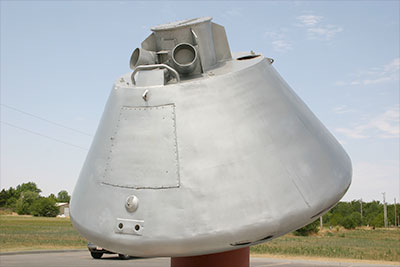 |
APG85
Member Posts: 311
From:
Registered: Jan 2008
|
 posted 02-02-2014 01:13 PM
posted 02-02-2014 01:13 PM
  
quote:
Originally posted by moorouge:
Apollo boilerplate BP-1206, then in the possession of the 67th ARRS located at the Woodbridge RAF...
The only picture (that I can find) that I took of BP-1206 on the 67th ARRS flight line at RAF Woodbridge in the late 80's. Not a great photo. I took it from one of our HC-130's as we taxied down for take-off. You can see it in the distance sitting in front of the HH-53 hangar. 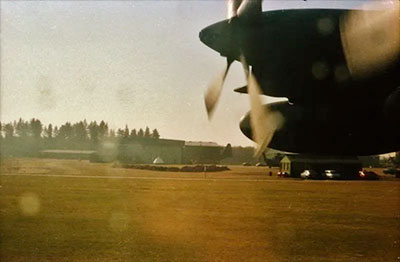 |
moorouge
Member Posts: 2486
From: U.K.
Registered: Jul 2009
|
 posted 02-03-2014 01:53 AM
posted 02-03-2014 01:53 AM
   
Here's another view of the Woodbridge boilerplate after it was moved away from the public gaze. One can just spot the tip behind the fence in front of the low building on the left of the picture.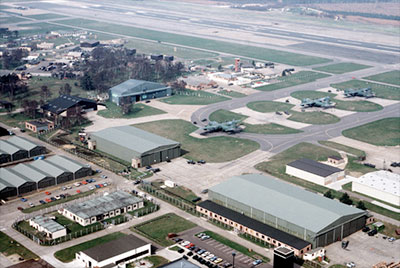 |
APG85
Member Posts: 311
From:
Registered: Jan 2008
|
 posted 02-03-2014 08:18 PM
posted 02-03-2014 08:18 PM
  
quote:
Originally posted by moorouge:
However, following the Rendelsham UFO incident it was moved...
The move of the Woodbridge boilerplate to make way for the construction of a new maintenance supervision building next to the helicopter hangar. The logical place to put the boilerplate was next to the Pararescue (PJ) building since they had done the most training with the boilerplate originally. I was stationed at Woodbridge in the 67th ARRS (later the 67th SOS) from 1985-1992. |
moorouge
Member Posts: 2486
From: U.K.
Registered: Jul 2009
|
 posted 02-04-2014 02:57 AM
posted 02-04-2014 02:57 AM
   
As former 67th ARRS you might like this.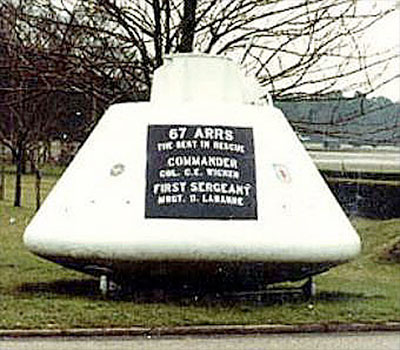 |
APG85
Member Posts: 311
From:
Registered: Jan 2008
|
 posted 02-05-2014 05:39 AM
posted 02-05-2014 05:39 AM
  
Nice picture. I believe this is the the road leading to the 67th ops building (just off the main road on base). The boilerplate was not in that location when I arrived in 1985 and was on the flight line in my time at Woodbridge... |
moorouge
Member Posts: 2486
From: U.K.
Registered: Jul 2009
|
 posted 08-30-2015 11:04 AM
posted 08-30-2015 11:04 AM
   
quote:
Originally posted by moorouge:
I have found a boilerplate Apollo capsule that was sunk.
Just a couple of extra points about the boilerplate sunk by the USS Phillip in the Pacific.The Niagara Falls Gazette carried the story a day before it appeared in the New York Times on 26th May 1967. It quotes the capsule as having cost $10,000 and had been dropped the night before as part of a recovery exercise some 100 miles southwest of Hawaii. There is a divergence in the accounts as the Gazette says that 3" guns were used, not the 5" as mentioned in previous posts. |
manta22
New Member Posts: 3
From: Tucson, AZ, USA
Registered: Nov 2014
|
 posted 12-25-2016 04:35 PM
posted 12-25-2016 04:35 PM
   
quote:
Originally posted by dtemple:
...the company was involved in aircraft scrap and salvage so based on that fact BP-14 was probably reduced to scrap metal.
Boilerplate 14 was, indeed, sold to Kolar in Tucson, Arizona, many years ago. While it was in that scrapyard I removed the Westinghouse DC/AC inverters from that module and have them in my collection. Whatever happened to BP-14 after that is unknown. |
moorouge
Member Posts: 2486
From: U.K.
Registered: Jul 2009
|
 posted 01-19-2017 11:58 AM
posted 01-19-2017 11:58 AM
   
I now can add a couple of updates: |
IanThePineapple
New Member Posts: 4
From: PA, USA
Registered: Dec 2016
|
 posted 08-03-2019 12:26 AM
posted 08-03-2019 12:26 AM
  
I was reading about the Apollo boilerplates on A Field Guide to American Spacecraft, and saw that BP-30 had a well-detailed interior, and was intended for a third uncrewed Saturn V flight if needed. Are there any pics of the interior? I couldn't find any.Also, are there any interior pics of CM-115 (the one on display with the Saturn V at JSC)? I couldn't find any either. Lastly, is CSM-115A still lost? Thanks for the help! Editor's note: Threads merged. |
SpaceBram
New Member Posts: 9
From: Belgium
Registered: Mar 2017
|
 posted 08-05-2019 02:08 PM
posted 08-05-2019 02:08 PM
   
I am pretty sure CSM 115A was sold to Dutch tv personality Mr. Chriet Titulaer in the seventies. He displayed it during his big space exposition Space 1986 in Utrecht (The Netherlands). Afterwards, the capsule stood in his garden for years. Later, he sold it to the Japanese theme park "Space World." The theme park restored the capsule to make it more or less look like a finished one. I have pictures of the capsule like it looked in 1986 and a couple of years ago. In 2018, Space World closed down. I have no idea what happened with the capsule. |
spaced out
Member Posts: 3185
From: Paris, France
Registered: Aug 2003
|
 posted 03-25-2021 05:44 AM
posted 03-25-2021 05:44 AM
   
Is A Field Guide to Apollo Spacecraft still being updated? If not, is anyone else maintaining this kind of info?I have a document from the mid 70s that notes the whereabouts of around 10 Apollo BPs not included in the list on the Field Guide site. |
PeterO
Member Posts: 444
From: North Carolina
Registered: Mar 2002
|
 posted 03-25-2021 09:38 AM
posted 03-25-2021 09:38 AM
   
Does your list have one at Oyster River High School in Durham, New Hampshire (USA)? See the second post in this thread for my original query. |
Robert Pearlman
Editor Posts: 49316
From: Houston, TX
Registered: Nov 1999
|
 posted 03-25-2021 03:12 PM
posted 03-25-2021 03:12 PM
   
quote:
Originally posted by spaced out:
Is A Field Guide to Apollo Spacecraft still being updated?
I know Jim Gerard, who created and runs the field guide, would be keen to receive any information, even the website itself cannot be updated immediately. |
spaced out
Member Posts: 3185
From: Paris, France
Registered: Aug 2003
|
 posted 03-26-2021 04:11 AM
posted 03-26-2021 04:11 AM
   
Thanks Robert, I'll send him a mail. quote:
Originally posted by PeterO:
Does your list have one at Oyster River High School in Durham, New Hampshire (USA)?
No, sorry. |

















